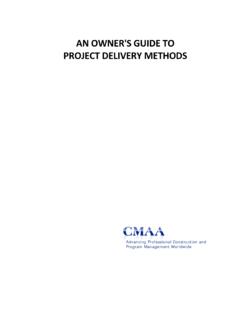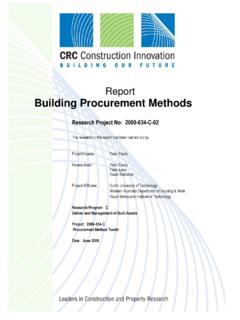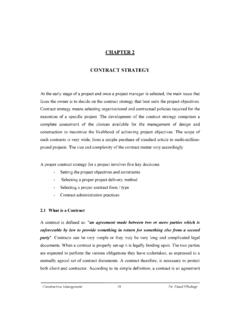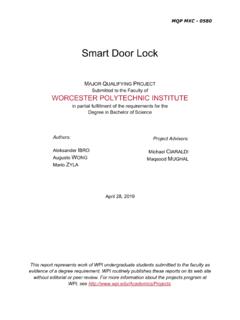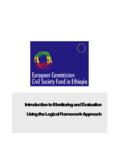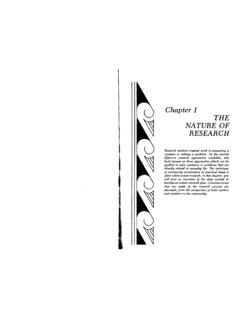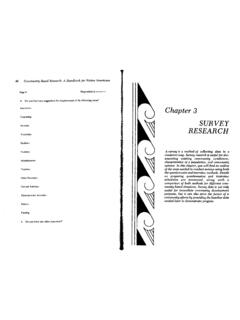Transcription of Estimating Total Cost of Bridge Construction using ...
1 Estimating Total Cost of Bridge Construction using Accelerated Bridge Construction (ABC) and Conventional methods of Construction PROGRESS REPORT Period Ending June, 2016 Submitted by Mohammed Hadi, , PE Wallied Orabi, Yan Xiao, , PE Jianmin Jia, Candidate Department of Civil and Environmental Engineering Florida International University, Miami, Florida Submitted to Atorod Azizinamini Director, ABC-UTC September 2016 A. DESCRIPTION OF RESEARCH project According to the Department of Transportation status report of 2013, of the Total bridges in the United States are either considered structurally deficient or functionally obsolete. There is therefore a pressing need for significant Bridge repair and replacement efforts (DOT 2013). These Bridge projects create a challenge to State Transportation Agencies (STAs) across the country in order to minimize the associated traffic disruptions in a safe way, while preserving the quality of the work and fulfilling budget constraints.
2 In an effort to combat this challenge, the Federal Highway Administration (FHWA) is adopting and promoting the implementation of accelerated Bridge Construction techniques (ABC) through the Every Day Counts initiative to expedite project delivery and minimize their impacts on the transportation network (FHWA 2012). Accordingly, a number of STAs are implementing ABC techniques and experienced positive outcomes in a significant number of Bridge replacement and/or rehabilitation projects. However, ABC techniques are often associated with high initial costs, which deters many STAs from a wider implementation of these techniques (TRB 2013). In addition, the impact of adopting these accelerated techniques to current Bridge design and Construction processes is not fully understood, which adds to the complexity of choosing ABC over conventional methods in Bridge projects.
3 Therefore, there is a pressing need to provide decision makers with a comprehensive tool for Estimating the Total cost of ABC projects including: Construction , indirect, agency cost, and user costs. This tool will facilitate comparing the Total cost of Bridge repair and replacement work under both ABC and conventional methods . Problem Statement Accelerated Bridge Construction (ABC) methods have been successfully used by many STAs for both planned and emergency Bridge projects. However, the Total cost of ABC projects are not completely understood let alone being included in the decision making process for such projects. This Total cost include: Construction , indirect, agency, and user costs. These costs need to be analyzed and estimated to support better decisions in selecting ABC versus conventional Bridge Construction methods . However, this analysis and estimation process is a complex process as it involves the evaluation of different types of costs including but not limited to: Construction costs, engineering and inspection costs, user costs (with consideration of impacts on mobility, reliability, motorist and Construction worker safety, and emission), right of way, quality of work, and the impact on surrounding communities and businesses (Salem & Miller 2006).
4 Unfortunately however, the lack of appropriate tools inclusive of the aforementioned factors does not allow the agencies to fully realize the true benefits and appreciate the true costs of ABC compared to conventional Bridge Construction . In order to address these gaps in both the body of knowledge and current ABC practices, the objectives of this project are to: (1) better understand and estimate the costs associated with ABC; and (2) Analyze different ABC case studies to determine the drivers and barriers for implementing ABC as well as performing a benefit-cost analysis. Brief Description of Current Practices of ABC Decision Making There are a number of existing tools that are currently in use by or available to STAs to support their decision-making related to ABC; these tools can be categorized under two main categories: qualitative and AHP-based quantitative tools, as shown in Figure 1.
5 Figure 1: Current Decision Making Tools for Bridge Construction Projects Qualitative tools currently in use by STAs include flowcharts, matrices, and questionnaires. One of the most widely used qualitative tools is the FHWA flowchart (FHWA 2005) that is designed to assist decision makers in determining whether the use of prefabricated bridges is suitable for their projects or not. The flowchart (Figure 2) includes questions related to major factors that might trigger the use of ABC, such as: average daily traffic; whether it is an emergency Bridge replacement project ; whether the Bridge is on an evacuation route; detours and lane closures times; and whether the Bridge Construction is on the critical path of the project schedule. If the user answers no to all these questions, the use of ABC is only justified if it improves safety and/or if the Construction cost is less than that of conventional Bridge Construction .
6 Alternatively, if the answer to any one of five aforementioned questions is yes , then the decision maker should consider ABC after examining the Bridge s need for rapid Construction , and the associated safety and costs impacts. Similar decision making practices are followed in other qualitative tools, such as the FHWA matrix and STA questionnaires. This kind of subjective practice that uses a yes/no and/or Likert scale approaches to evaluate ABC projects is insufficient in identifying and evaluating the true costs of ABC methods . Figure 2: Flowchart for PBES Decision Making AHP-based quantitative tools are also used for ABC decision making. One of these tools, and perhaps the most well-known ABC decision making tool, is developed by the Oregon Department of Transportation (ODOT) in collaboration with seven other DOTs (Doolen et al. 2011). In this tool, five main decision criteria are considered: direct cost, indirect cost, schedule constraints, site constraints, and customer service.
7 Furthermore, a set of sub-criteria was developed for each of these five criteria as seen in Figure 3. The tool guides the decision makers through performing two-step pair-wise comparisons between the Construction alternatives for each of the criteria selected by the users based on their goals and priorities. This method considers myriad factors and reduces the very high subjectivity inherent in the qualitative tools by attempting to assign scores to each Construction method based on its performance in each of the criteria considered. However, these scores and their relative weights are still subjective since they are assigned based on the user s perceptions rather than objective evaluation and in-depth analysis. These tools are therefore susceptible to underestimation or overestimation of the utility of different alternatives. While such methods might be suitable for inherently subjective criteria, such as customer service, they are insufficient to objectively evaluate criteria such as Construction , indirect, and user costs.
8 Figure 3: ODOT AHP Tool Decision Criteria and Sub-criteria Another important component in decision-making process is to assess the user costs. The Work Zone Road User Costs Concepts and Applications report produced for the Federal Highway Administration presents a framework for the use of user and Construction costs in alternative analysis and associated decision making process. The report also discussed how the unit cost of delays, vehicle operating cost, crashes, and safety can be calculated based on outputs from tools and methods that can calculate these parameters. A number of tools have been developed to assess the impacts of work zones o mobility. The FHWA Traffic Analysis Toolbox Volumes VIII and IX classifies these tools to sketch planning tools, traffic demand models, signal optimization tools, macroscopic simulation, mesoscopic simulation, and microscopic simulation.
9 These documents provide guidance to assist in selecting between these different types of tools based on various factors. The sketch planning tools range from simple spreadsheets that allow the analysis of a single link (like the Q-DAT developed for Texas A&M) to slightly more complicated tools like the QuickZone developed by FHWA that allows the modeling of multiple links on the subject facility and alternative route. A good example of macroscopic simulation models are the tools that implement the freeway and urban street facility procedures of the Highway Capacity Manual (HCM) including the soon to be updated work zone procedures in the 2015 update of the HCM. An example of the use of demand forecasting-based and simulation-based dynamic traffic assignment modeling tools is the WISE approach developed as part of the SHRP 2 R11 project . Most of the above mentioned tools do not consider in details reliability, emission, and safety impacts.
10 Recent information, tools, and findings from the TRB SHRP 2 Reliability program, EPA MOVES emission modeling, and Highway Safety Manual (HSM) procedures are not considered. Real-word data from advanced monitoring systems and other sources are also becoming available that will allow the provision of more detailed data to the developed tools and to confirm their performance. The use of the data needs to be further considered to support the decision making processes related to ABC Construction . Contribution to Expanding Use of ABC in Practice Development of a comprehensive tool that has the capability of Estimating the Total cost of ABC projects and compare them with those of the conventional methods will help decision makers in understanding and evaluating the true benefits and costs of ABC methods at an early stage of the project development which, in return, will lead to the expansion in the use of ABC methods versus the conventional ones.
